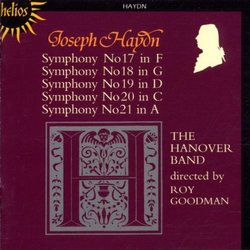| All Artists: Haydn, Goodman, Hanover Band Title: Symphonies 17-21 Members Wishing: 0 Total Copies: 0 Label: Hyperion UK Release Date: 6/11/2002 Album Type: Import, Original recording reissued Genre: Classical Style: Symphonies Number of Discs: 1 SwapaCD Credits: 1 UPC: 034571151151 |
Search - Haydn, Goodman, Hanover Band :: Symphonies 17-21
 | Haydn, Goodman, Hanover Band Symphonies 17-21 Genre: Classical
|
Larger Image |
CD DetailsSimilar CDs |
CD ReviewsExploring the Haydn Symphonies -- Nos. 17 --21 Robin Friedman | Washington, D.C. United States | 05/11/2006 (4 out of 5 stars) "The consecutive numbering of these five early Haydn symphonies (17,18,19,20,21) masks substantial differences in their styles. dates of composition, and musical interest. Roy Goodman conducts the Hanover Band in this reissue, part of a project of recording the complete Haydn symphonies that, unfortunately, was never quite concluded. Goodman conducts from the harpsichord, making the best educated guesses on performance practices in Haydn's day, with the orchestra performing on period instruments.
My information on the chronology of these works for this review is drawn from the excellent liner notes and from the discussion of Haydn's symphonies in the Oxford Composer Companion to Haydn, edited by David Wyn Jones. The earliest work on this CD is probably the symphony no. 18 in G major, generally thought to date from before 1761. This work is in three movements and is lightly scored, including only strings, oboe, horn, and the continuo. This work is in the style of an early church sonata, and it opens with a slow movement, at a walking pace in the strings accompanied by the horn, with a theme that is repeated several times. The second movement is fast and energetic, and the symphony concludes with a minuet. The three-movement symphony no. 19 in D major is short (about 10 minutes) and, unlike its numerical predecessor, opens with a lively allegro which develops its theme over its brief compass. The poignant second movement is in the minor key for strings alone, and Haydn divides the strings into two lines for a moment at its climax. The work concludes with a contrasting, energetic presto with the horns playing a large role. The four-movement symphony no. 20 in C major is probably also one of Haydn's earliest works, even though it includes trumpets and drums. As is usual with Haydn's C major symphonies, this is a festive, ceremonial work beginning with a flashy opening movement in which the trumpet and tympani have a large role. The second movement, for strings alone, presents a flowing, legato theme played over a hushed accompaniment in broken chords in the lower strings. The minuet is full of pomp and glitter, and the symphony concludes with a presto finale with much brass fanfare. The three-movement symphony no. 17 in F major may be slightly later than the above works. The first and third movements are in the galant style, but the most memorable movement of this work is the andante, a restrained, chamber-music like movement for strings alone in the minor key. It would be difficult to take any five Haydn symphonies without finding a little-known treasure. The finest work on this CD is the symphony no. 21 in A major which probably dates from 1764, during Haydn's early service at Esterhazy. This work, like the symphony no. 18 and the more famous following symphony no 22 (the "philosopher") is in the style of the sonata de chiesa, featuring a slow opening movement. The opening movement of no. 21 shows a wonderful fluidity with contrasting passages for the strings and the oboe. The second and final movements are closely related in their themes, rhythms, and lively, energetic pacing. Between them lies a slower-paced minuet. The Oxford Companion to Haydn notes that "with justification, many commentators have regarded the symphony as one of Haydn's finest." It is a delightful find indeed. This CD will appeal to lovers of early classical music and to those interested in the development of the symphony. Robin Friedman " |

 Track Listings (17) - Disc #1
Track Listings (17) - Disc #1
